PPC can make a significant difference in your business. According to WordStream, 64.6% of searchers click on Google Ads for keywords with high commercial intent.
Table of Contents
- 1. Optimizing ads and landing pages for mobile devices
- 2. Recognizing social media as a vital platform
- 3. Tracking conversion
- 4. Marketing automation
- 5. Optimizing ads for voice search
- 6. Creating a PPC task checklist
- 7. Considering seasonality
- 8. Reviewing and adjusting ad budgets
- 9. Geo-targeting of ads
- 10. Examining Keyword performance
- 11. Performing keyword research
- 12. Reviewing landing pages
- 13. Reviewing overall CTR and sales
- Conclusion
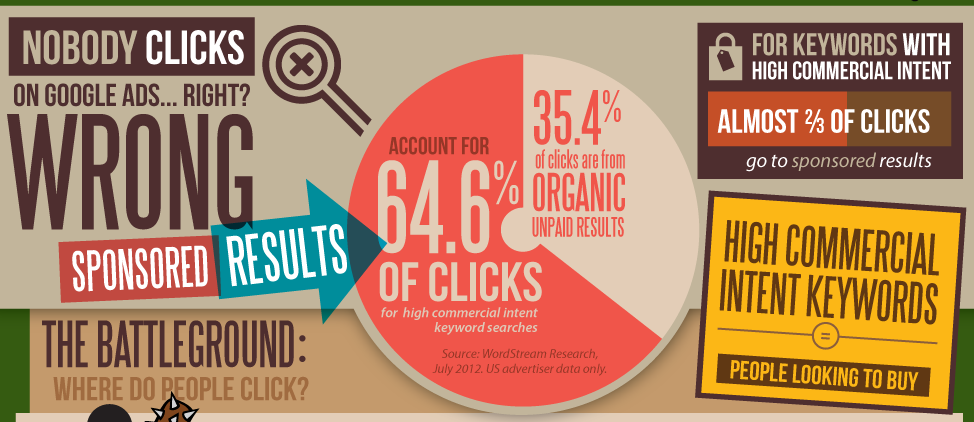
With most marketing channels, there are both success and failure stories. One thing an advertiser needs to note is that spending money is only part of your PPC advertising. The way you spend the money is what determines whether you will make a profit or experience losses.
Another vital part of PPC advertising, apart from the amount you want to spend, is the relevancy of your ads and landing pages. Ads and landing pages that provide value end up spending less on advertisements. Also, these ads get better click through rates (CTR) which translate to more sales. Which is what you want, right?
This post explains some trends you need to follow to improve the CTR of your PPC ads and to increase sales on your landing pages.
1. Optimizing ads and landing pages for mobile devices
Mobile devices are one of the biggest trends in Internet traffic right now, and have been for a while. But now, they’ve overtaken desktops in terms of how much traffic they are generating. This shift has become obvious with Google’s announcement of its mobile-first indexing system, which means the mobile version of the website will be indexed into the search engine before the desktop version. Whether you are spending your pay-per-click advertising money on Google searches or social media, optimizing your ads and landing pages for mobile is a no-brainer.
With more searches being performed on mobile devices than computers, having mobile-responsive pages is a plus for websites. For websites that have poor mobile pages, the increased traffic will be an issue, and they may start getting lower rankings on Google result pages and, consequently, a lower amount of traffic.
You may be wondering how this affects you as a PPC advertiser. It does because automatically bidding for a keyword doesn’t guarantee you a placement in the search results for that keyword. Google wants to know that your ad will provide value to users who click on it. When your ads perform woefully on the search results page, you get a low quality score for them. In which case, you’ll have to pay more for your ads, which can eliminate your ROI. In fact, a low quality score for your ads can increase your cost per click by 400% and cost per action by 64% while a high quality score can reduce cost per click by 50% and cost per action by 80%.
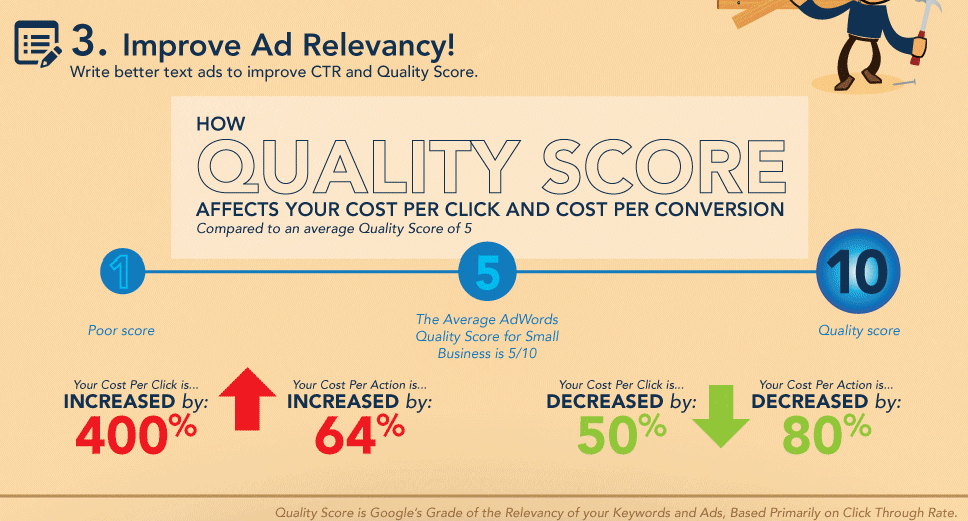
Your ads should be optimized for users on mobile devices like smartphones and tablets. And as popular as the mobile phenomenon has been, fewer than 20% of AdWords accounts have set up mobile preferred ads.
One way you can make your ad friendly to mobile is to include a click-to-call button on your ad. This allows mobile users to call you through your ad and make necessary inquiries about your services or product. Having a call extension on your ad can increase your click-through rate by 10%. Unfortunately, 19 out of 20 ads don’t have call extensions set up on their campaigns.
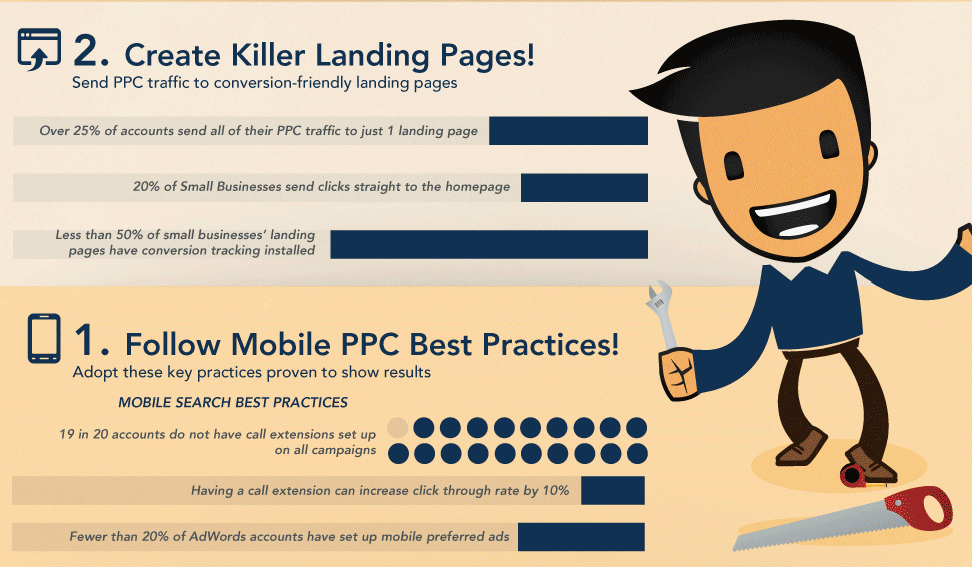
Likewise, advertising on social media requires that you optimize for mobile devices, as mobile usage for social media is even stronger than search. For instance, 51.7% of Facebook users access the website exclusively on mobile. An ad that is formatted only for desktop is losing the majority of its potential lead.
Creating your ad is only the first step. Even though users may click on your PPC ad, the only thing that happens is that you pay for the ad. You have not made money yet. You must convert your visitor into a customer.
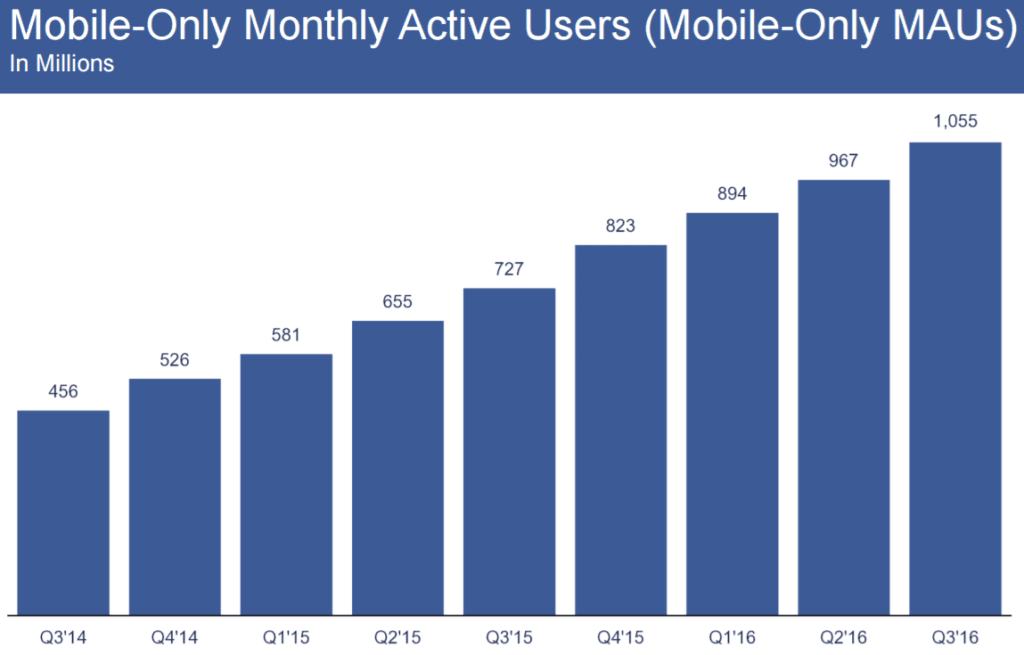
To do this, you have to optimize your landing pages for mobile devices. Having a high click through rate is the first step towards conversion. The second step is for your visitor to perform your intended action. A poor mobile experience will result in a bounce for many of your visitors, which hurts your conversion rate and costs you a lot of money.
2. Recognizing social media as a vital platform
The most popular form of PPC ads is through search engines, but over the years, social media has also proven to be a suitable PPC advertising platform for many marketers. Marketers are driving a lot of traffic to their landing pages and converting them for more business. With over 3 billion social media users, there is a big pool of potential customers.
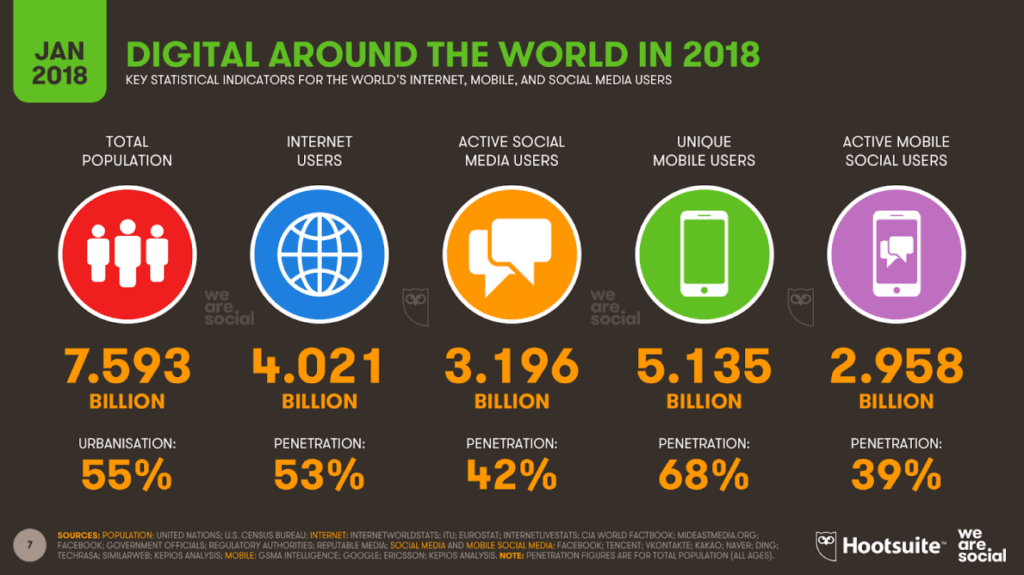
If you have not tried social PPC ads, then this is the time to do so. It’s another opportunity for your business to reach more people. Many users of social media visit these platforms daily to discuss all types of matters, from the trivial to serious business.
If you have a service that offers benefits to users, then you are bound to convert them because most people are looking for good deals. You can also target users based on the demographics of your ideal user. These demographics include location, gender, age group, device type, etc. With targeting, you can present ads that are relevant to your ideal audience.
To advertise on social media, you have to note that different social media platforms operate in different ways. For your PPC campaign, you probably don’t want to advertise on all social media platforms because that would be a poor strategy. Each platform is suited to a type of service or product. Some of the platforms you should consider for your PPC ads are:
• Facebook, the largest social media platform with 2.2 billion monthly users. For Facebook, any type of service or product you sell will have a large enough audience.
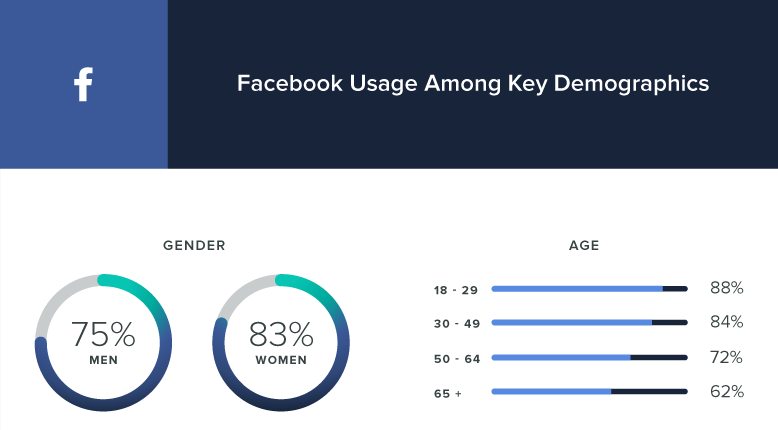
For almost every demographic, Facebook has the largest possible audience. Also, Facebook advertising is currently cheaper than advertising on Google. This is a platform you should consider if you are advertising on social media.
With Facebook advertising, SamCart’s co-founder Brian Moran was able to promote his retargeting Hacks report. He made $14,114 after spending $8,240.17 on the platform.
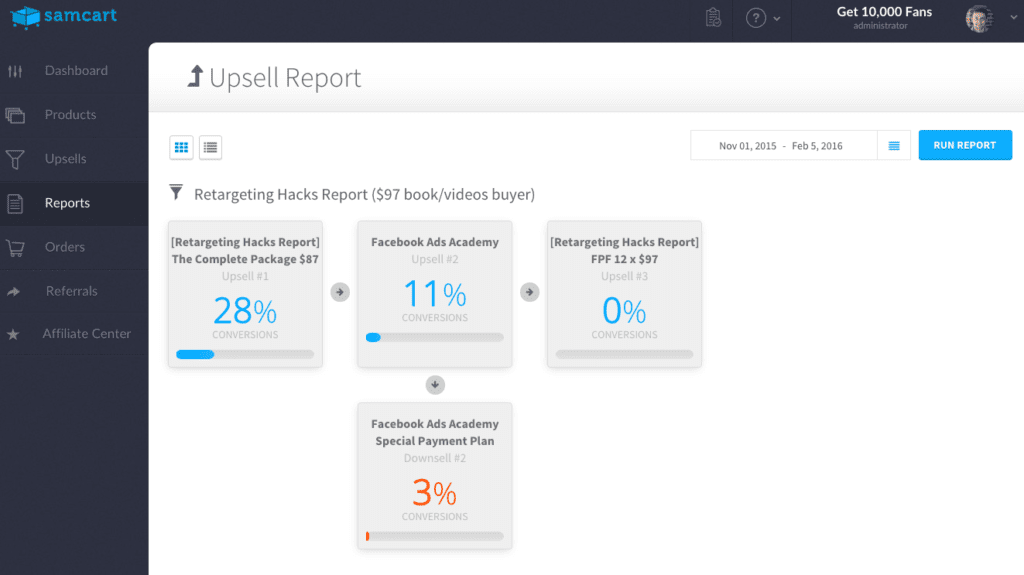
• Instagram is one of the largest social networks and is owned by Facebook. Instagram generally appeals to a young user base. Fashion items and other products used by millennials will suit the audience on this platform.
• LinkedIn is a platform for professionals, and it’s business-minded. B2B services and products will find a large audience on LinkedIn as many professionals are looking for opportunities to improve their businesses. Products that will help professionals achieve career progress will do well here. If you want to generate leads for your business, this is one of the best platforms for that.
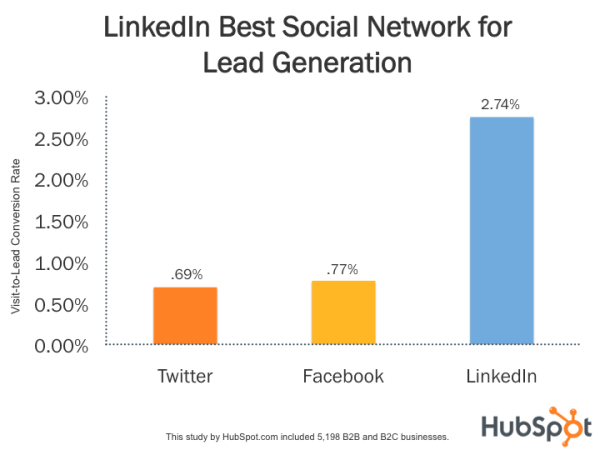
• Pinterest uses images and video content mostly. One thing Pinterest is known for is its female population. 92% of users on Pinterest is female. Also, Pinterest is the largest social media platform for food.
• Twitter has a large base of a variety of demographics, and you can reach your audience through it.
• Snapchat is similar to Instagram in user demographics, with a user base that is mostly comprised of millennials. Fashion items and visual products will do well on here.
3. Tracking conversion
If you want to get the best out of your PPC campaigns, you need to be able to track their conversions properly. Conversions are the way to know if you have achieved your campaign goals or not. Having this knowledge means the ability to make the right changes and to craft new strategies for your campaigns.
![]()
Although conversion tracking may seem like a common sense thing to do, less than 50% of active AdWords account have conversion tracking implemented. Without proper tracking, you have a wrong view of what your conversion is. The resulting problem is that you base your future strategy on the wrong value. This is why many marketers lose money and wonder how it got lost.
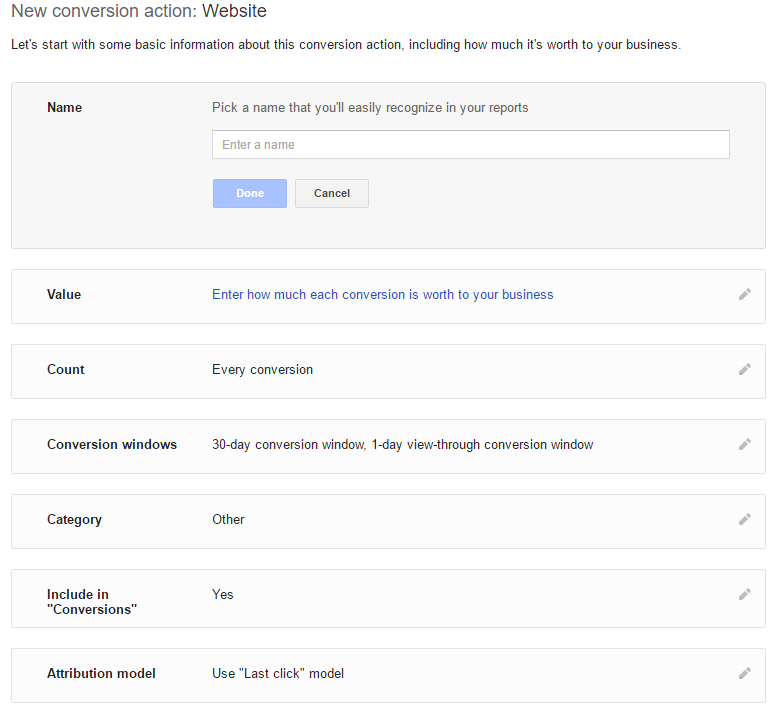
In fact, HubSpot estimates that 97% of campaigns with poor tracking don’t produce a positive ROI. If you’re currently losing money in your campaigns, you need to check and be sure that you’re tracking your conversions correctly.
4. Marketing automation
During a campaign, so many things need to be tracked that you may be unable to track it all. Even if you can manage that, tracking users’ behavior on your landing pages would be almost impossible. Combining your PPC campaign with marketing automation helps you get the best out of your campaign.
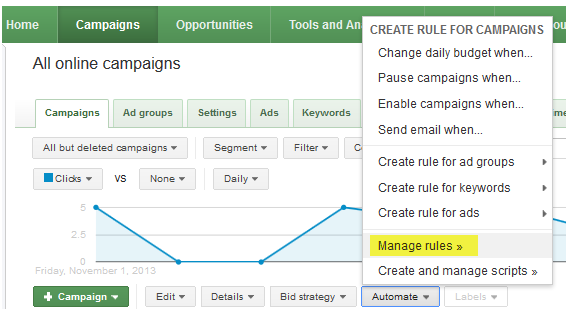
With marketing automation software, you can track the performance of your landing pages. If you capture leads on your landing page, you can add these leads to an automated sales funnel in your marketing automation software. When you make sales, you can also tag these customers for “Thank you” emails and send them future promotional offers. With marketing automation, you can easily follow up with leads or customers you gain through advertising.
5. Optimizing ads for voice search
Today, voice search is becoming more popular. 20% of Google searches performed on Android devices in 2016 were voice searches. You can expect it to be even more than that, now, as voice search is easier to perform than a typed search.
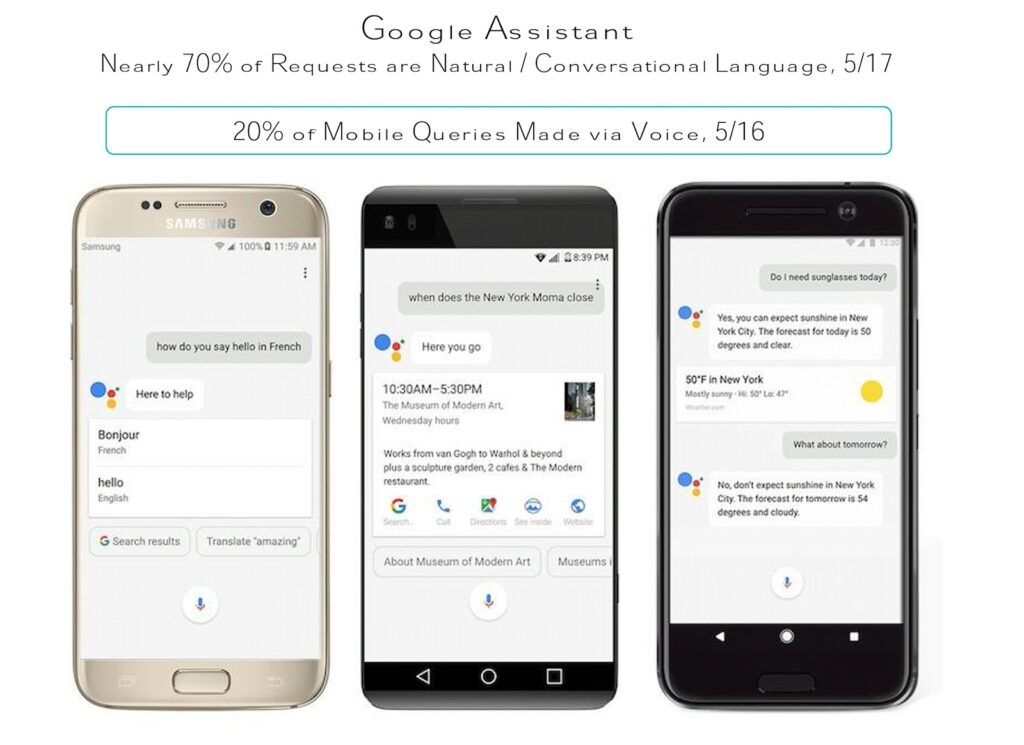
Furthermore, voice recognition systems are now more accurate than before as they are as competent in recognizing speech as humans. Currently, voice recognition systems have an error rate of 5.1%.
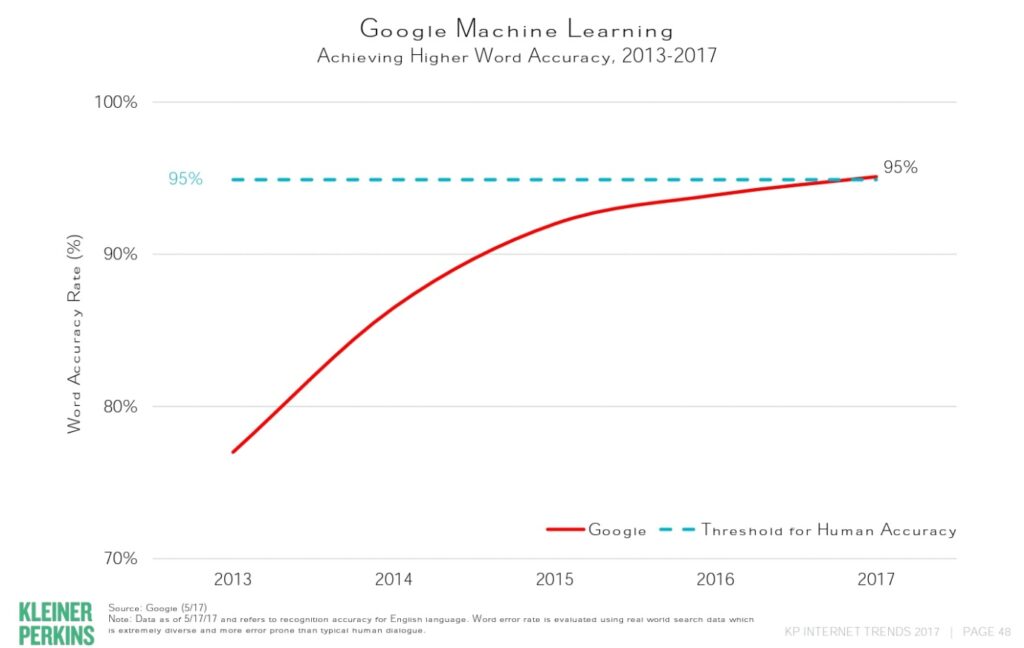
The risk of searching for something different from what you say is far less than it used to be. If you’re a PPC marketer, though, you must note that there are some differences between voice search and typed search. These differences are:
• Voice search queries are longer. Since people can talk faster than they can type, they can usually say more words in the time it takes them to type a search query. It’s common to find voice search terms with five or more words.
• Voice search is conversational .Most times searches use terms people use when asking another person questions.
• Many voice search terms will start with how, who, where, when, why, and what.
If you’re targeting voice search for your PPC campaign, then you should target keywords that show your desired user intent. For instance, if you’re advertising a law firm, keywords like, “Where is a law firm near me,” or, “Law firms near me,” show more intent you than, “How to begin a law firm.”
Voice search optimization is especially important if you’re advertising a local business. Google found that 50% of smartphone users and 34% of computer/tablet users who perform local searches visited a store within 24 hours.
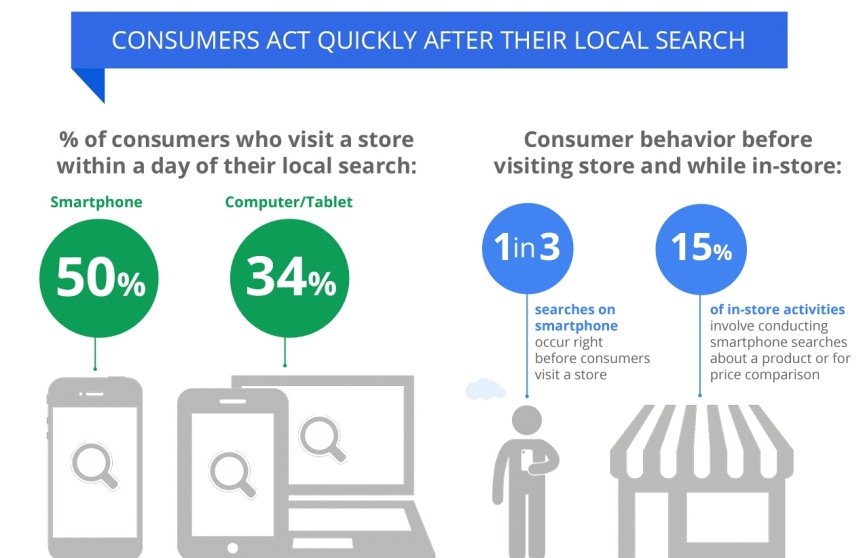
6. Creating a PPC task checklist
If you run a PPC ad account, there are some activities you should engage in regularly to ensure your ads are running effectively at the lowest possible cost.
• Check ad spending and revenue regularly. Your main aim in running ads is to make a profit for your business. You need to compare the amount you’re spending on the ads to how much you’re making. If you have a big ad account, you should do this daily to keep up with all the details.

• Check ad positions. Your ad position will affect the number of clicks you have on your ad. You want your ads to be ranked first as that translates into a higher probability of getting more clicks. You need to check the position of your ads at least once a week. This will give you insight in to whether to increase your bid for some keywords or to focus on improving your quality score.
• Check display network placements. If you’re running banner ads, you need to check where your ads are shown and their performance at those locations, helping you make decisions on where to exclude your ads.
7. Considering seasonality
Often, sales fluctuate throughout the year. This is not because your campaigns are not effective but because sales can vary depending upon the season. People tend to buy more during some seasons than others. For instance, people tend to buy more during the holiday seasons. Statistics show that 19% of annual sales are made during the Christmas season.
If you have a product that is affected by holidays, you should adjust your ad title and copy for each holiday.You can give limited time offers or discounts during this period to attract more buyers.

For some, business sales fall during holidays because people don’t use the good or service during the holiday. If you’re in this category, you can pause your ad for the period.
Different seasons also need different products. For example, people need sweaters during the winter, but no one needs one during the summer. If you sell such a product, you should always adjust your ads for offers close to the season when potential customers will be looking to buy.
Another thing to consider is special events during the year. One of them is Black Friday. Many people wait for this time to shop because they can buy goods at a cheaper rate. Your ad should reflect a promotional offer a few days before Black Friday to capture people looking for deals. Other special events are Mother’s Day, Father’s Day, and the Super Bowl. With your promo, you can add a timer to create urgency for searchers.
8. Reviewing and adjusting ad budgets
One thing you have to constantly take note of is your ad budget. You have to be sure that your keyword bids are profitable enough for your business. Likewise, you also need to make sure your ad has a high rank to ensure visibility to potential customers.
To reduce your ad budget to the lowest cost possible, you need to consider these tips:
• Increase your quality score, a value from 1 to 10 with 1 being the lowest and 10 being the highest. The quality score is calculated based up on the relevance of your ads to searchers. It is also affected by the click-through rates of your ads and the quality of your landing page. Having a high quality score helps your ad rank high, and you pay less for clicks.
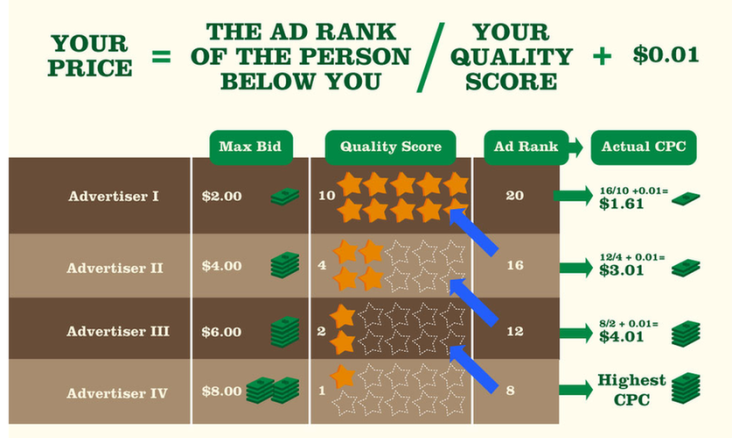
• Check for expensive keywords. Some keywords are expensive due to the level of competition for them or how profitable they are. If a keyword becomes too expensive, you can stop using it. Then you can try a long-tail variation that shows the intent you want. It may have lower traffic but be more likely to lead to sales.
9. Geo-targeting of ads
Some services are more suitable to some locations than others. If you pack snow, your services may not be needed in a place like Nigeria; whereas, Canada and Sweden need those services. Whatever service you offer, traffic from some locations won’t help your business, and paying for traffic will be a waste of money. Geo-targeting allows you to target only those locations you know your business can serve.
How do you go about it? To set up geo-targeting for your ads, select the campaign you want to target and click on the “Settings” tab. Scroll down to the “Locations” section and click on “Edit.”
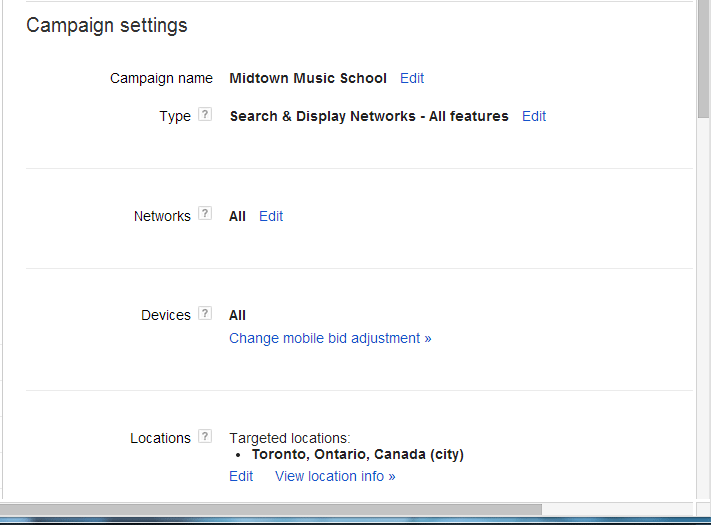
After that, click on “Search” and type the location you want to target. You can choose to target a whole country, state, city, or postal code. You want to pick a location as small as possible, especially if you run a local business.
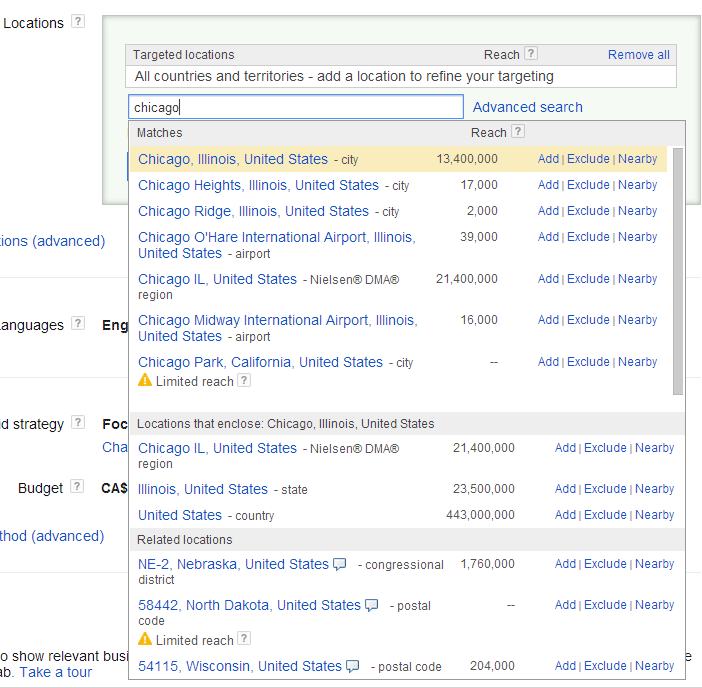
When you search for a location, the possible reach is displayed beside it. Other options beside that are “Add,” which allows your ad to be displayed in that location; “Exclude,” which prevents your ad from showing in that location; and “Nearby,” which shows you other locations close to your chosen location.
If you select a region (state or province), the map of the area will appear with the region highlighted. If you have selected more than one region, you’ll see both regions highlighted on the map.
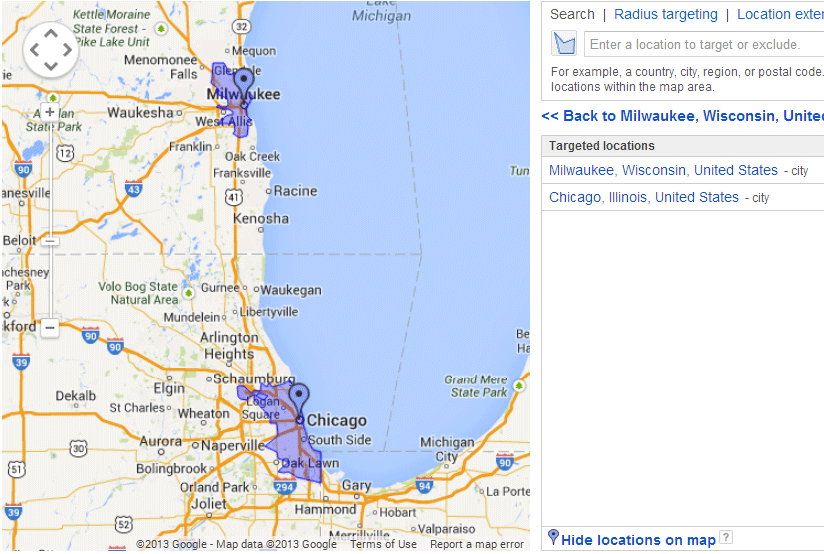
You can also target a particular radius. Let’s say you have a restaurant or a laundry business, you might want people within a specific radius to see your ads. If that’s the case, your business location will be the center of the radius. To do this, click on the “Radius Targeting” tab. Then you enter the location that you want to set as the center of the radius. You then specify the radius by typing the number. You’ll also specify whether the distance is in miles or kilometers.
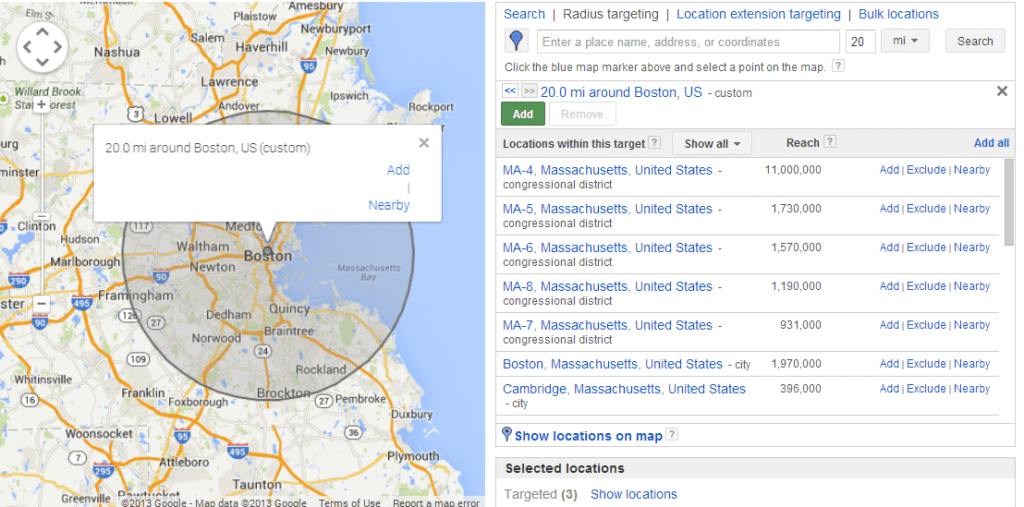
You can also add or exclude many locations at the same time. Click on “Bulk locations” and add all the locations you want. Your locations must be in the same country, and you have to indicate this country code.
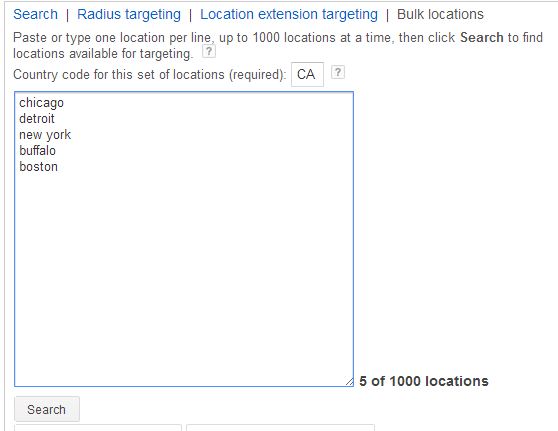
To view more details about your selected location, go to “Locations” under “Settings.” You will see the traffic from each location, the number of impressions, clicks, average cost-per-click (CPC), and average position. You’ll also see these details for “Total – other location,” which is traffic from areas you have not targeted.
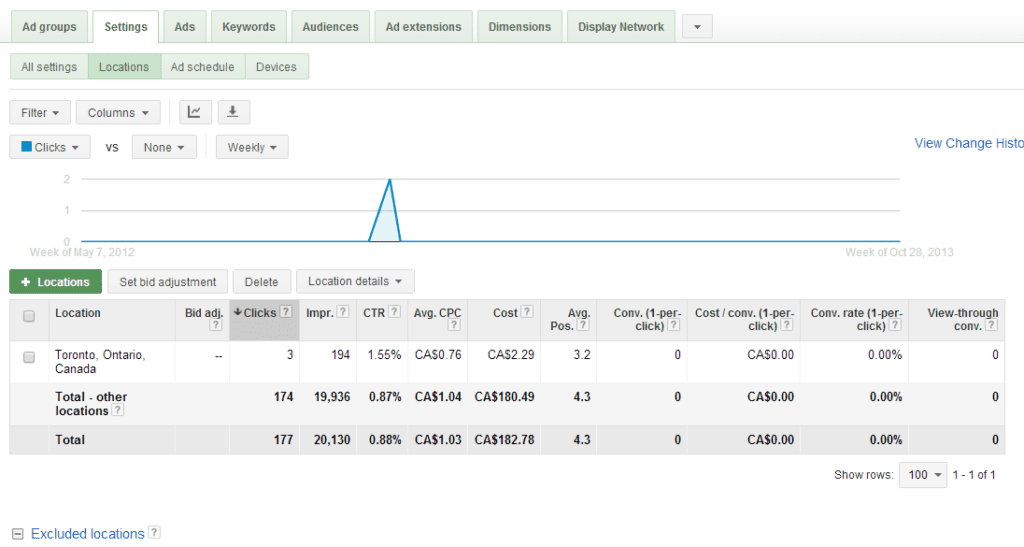
With these numbers, you can serve ads that are more relevant to searchers and will attract more traffic and create more conversions.
10. Examining Keyword performance
You need to keep an eye out for keywords that have high impressions but low CTRs. If you find yourself in this situation, you need to look for the cause. It may be the headline of your ad or an irrelevant offer below the headline. You can perform different tests on your headline and the description to see if the click-through rate improves.
You should also look for keywords that have huge traffic but low conversion. If your ad has a good click-through rate but conversions seem to be low, your landing page probably has issues. For example, does the offer on your landing page match that on your ad? If it doesn’t, a visitor may bounce if the offer your ad promises can’t be found. When you add an offer to your ad, you should make sure to add that offer to the connected landing page.
To download your keyword performance report, login to your AdWords account. Click on the “Campaigns” tab. Then click on “Keywords.” Check to see that the report covers the period you want and the important columns, filters, and segments. Click on “Download Report.” After that, enter a name for your report and click on “Create.”
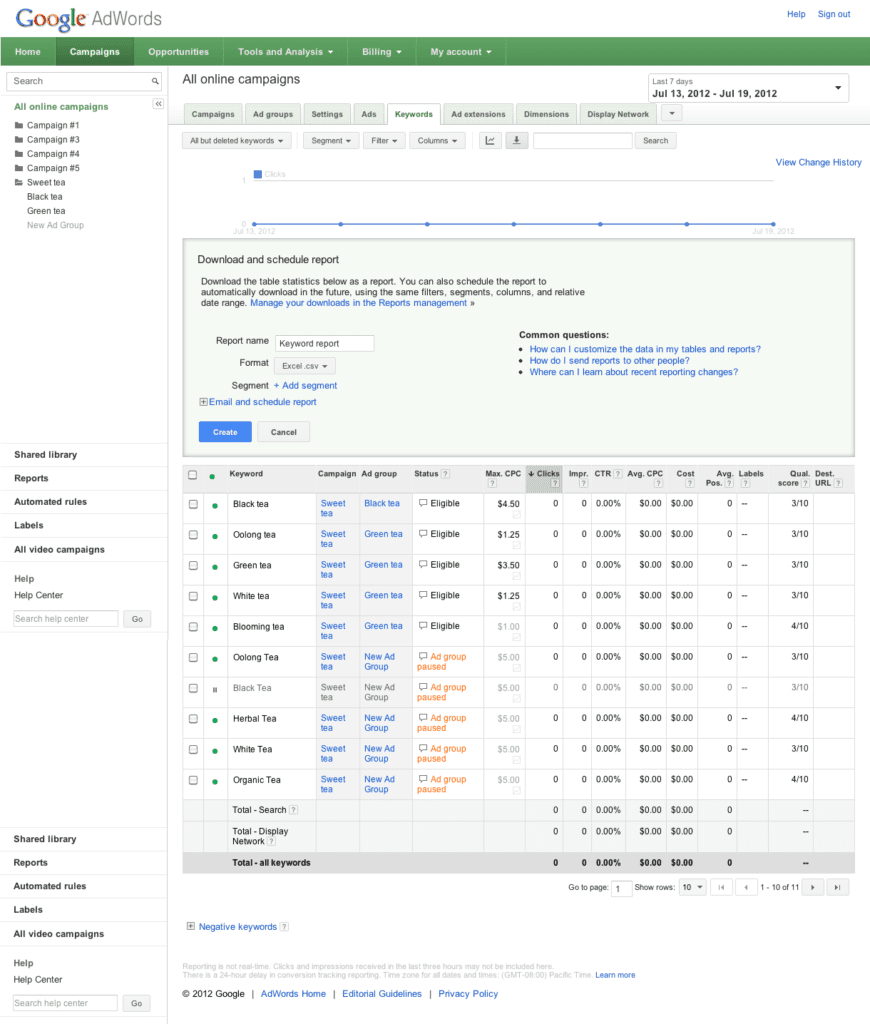
One way to check your keyword performance is to perform an ad audit. You should perform an ad audit every three or six months. You should review
• Ad rank. You need to check the rank of your ads on search results. You can check this using the average position column in Google Ads or Bing Ads. The best position is either the number one or number two spot. If you have a lower rank for an important keyword, you should improve your ad quality to improve the ad’s quality score and its position.
• Disapproved ads. For these ads, you can see why the ads have been disapproved and fix the problems.
• Ad placement. This is needed especially for banners. You need to see where your ads are appearing and if their performance is satisfactory. Exclude the places with poor performance.
• Keyword bids. You should check your keyword bid and see how it compares to the maximum cost per click (CPC). If the bid is close to the maximum cost, you can increase your bid. However, if you find that the cost per click and cost per conversion are too expensive, you can reduce your bid or pause the keywords.
11. Performing keyword research
If keyword research was a science, then everybody would have the process down pat. Of course, there would be no way to show creativity then. You can excel with keyword research when you understand your ideal customers.
Keyword research is a continuous process because you can’t gather all the keywords you need at once. You will discover some later that you can add on. There are generally four classifications of keywords:
• Brand terms are keywords that contain your brand name.
• Generic terms are keywords that relate to the product or service you’re advertising.
• Related terms are keywords that people may search for when they need your service, but theymay not mention the service specifically.
• Competitor terms are keywords that contain the names of your competitors.
To pick the right keywords, you have to consider the following:
• Start with broad terms. You can start your research with single or double terms that show no user intent. These are terms you use as a base for your keyword list. You should not target these keywords as the competition is high and they doesn’t show user intent. For instance, a term like “shoe” shows no intent unlike “buy winter shoe in Boston.”
• Move to longer search queries with three words or more that show intent. This has two advantages: low competition for these keywords and increased likelihood of searchers buying.
• Understand your customers. Everything you’re doing in your keyword research is to predict search terms that your potential customers will use to search for your product or service. When you understand your customers, you can predict more accurately the likely terms they’ll search when they need your services.
• Use the Google Ads keyword planner. The keyword planner shows you the average number of times a term is searched during a month. It also shows you the competition for that particular keyword. Ideally, you want to have a keyword that has high volume and low competition. If the competition is high, you’ll have to pay more before your ad can show up. If you have a limited budget, you should not go for the terms with high competition.
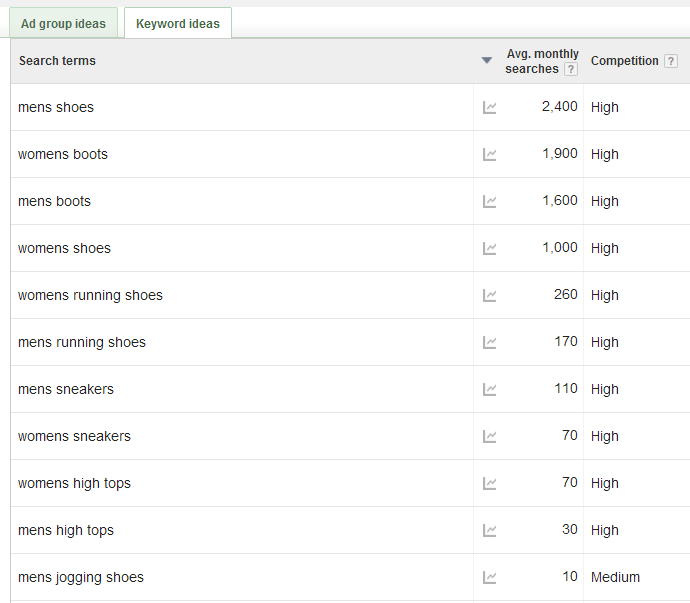
• Add negative keywords. These are keywords that you don’t want your ad to appear with when searchers search for them. To do that, go to “Campaigns” on your Google AdWords dashboard.
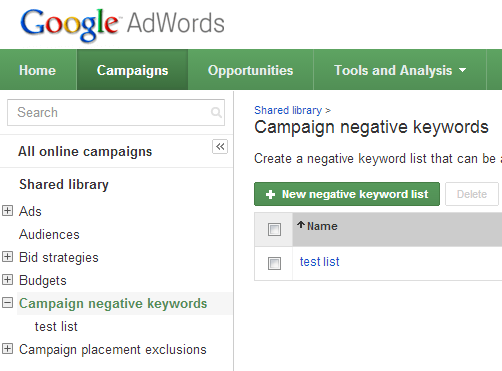
Scroll to “Campaign negative keywords” and click on it. Click on the “+ New negative keyword list” button.
12. Reviewing landing pages
For any PPC campaign, your landing page is where visitors get converted for your business. This is where you begin to make money. It is important that you constantly improve your landing pages to increase conversions.
To make sure your landing pages are working at their optimum level, you should never stop testing them. Some elements you can test on your landing page include
• Headline. This should indicate what your page is about and contain the offer in your ad. Through your headline, visitors know what offers they are going to get on the page. The aim of your headline is to get your visitors to read your landing page copy. There is no headline template that works for all businesses — which makes testing important for any landing page. You can test a variation of your headline and see what effect it has on your conversions.
• Landing page copy. The content on your landing page should convince your visitors to take your offer. Some copy is more convincing than others which is why you need to test variations to know what works for your audience. Test its style or length. Does your copy sound too formal? Would your audience be receptive to an informal style? Is it too short to convince your visitors or so long that visitors get bored before getting to the end? You need to test this and track the results.
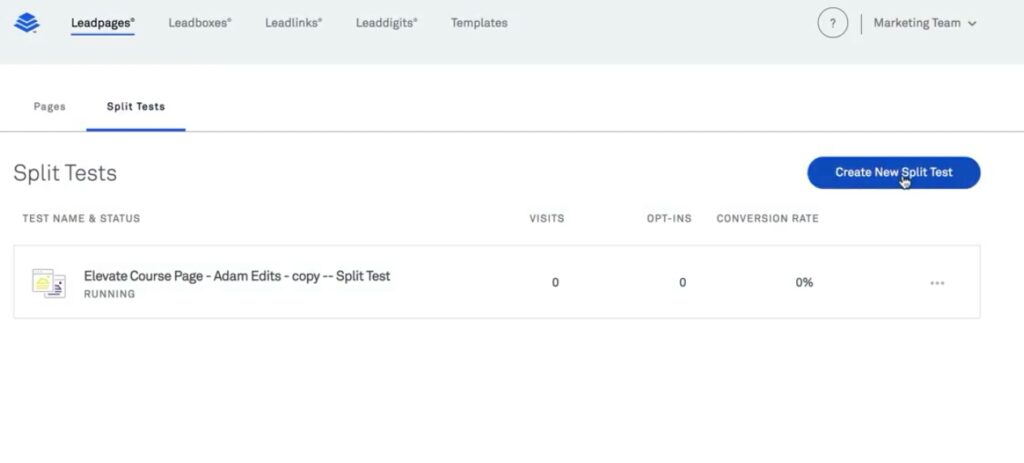
• Landing page background. Some landing pages have plain backgrounds while some have an image as their background. You can perform three variations of tests in this case. If your landing page has no background, you can add a background and track the results. If it has a background, you can also change the background or remove it.
• Images. Do you have only plain copy on your landing page? You can add an image to see if it has a positive effect on conversions. Another thing to test is the location of your image on the landing page.
• Video. You can also place a video on your landing page to complement the copy. This will help if you can explain the concept of your service with this video. Eyeview found that video on a landing page can increase conversion by 86%. In a case study, TutorVista was able to increase its landing page conversion by 86% when it added video.
• Position of lead capture form. If your landing page is to capture leads, you need to test the position of your lead capture form on the landing page. Another thing you can test is if the lead capture form should be on the page or as a pop-up when visitors click a button.
• Position of payment gateway. If your ad is linked to your sales page, you can experiment with the position of the gateway and track its effect on sales.
You should never stop testing your landing page as this helps you to find ways to improve its performance. Apart from what is listed above, you can get creative in testing various elements.
Black and Decker performed an A/B test on its call to action button text, testing 2 variations of “Buy Now” and “Shop Now.” They found that “Buy Now” got 17% more clicks than the other variant. This meant a 6-figure revenue increase.
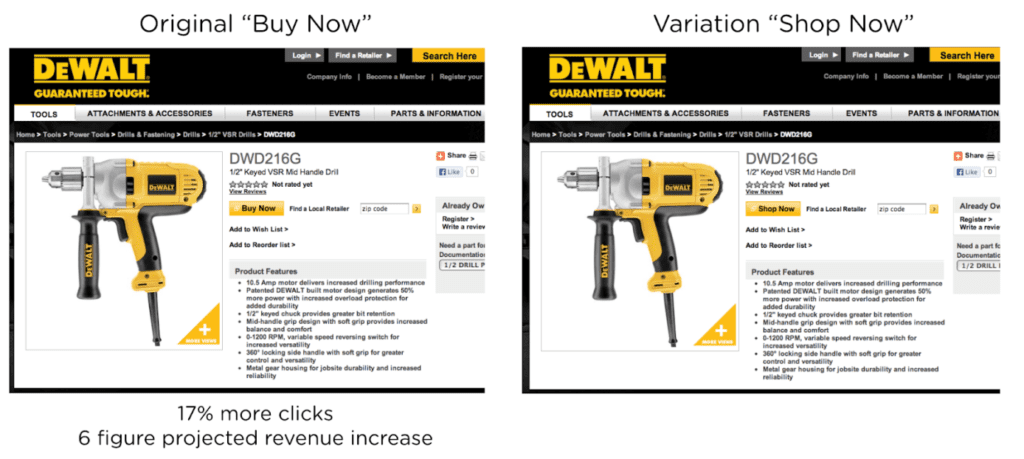
One thing to keep in mind while testing your landing page is that you should only test one element of your landing page at a time to ensure your results are reliable.
13. Reviewing overall CTR and sales
You need to keep records of your overall campaign CTR and the amount of sales you make. This gives you an idea of whether your campaign is achieving its goals and what changes need to be applied to it.
Conclusion
PPC advertisement is more of an art than a science because the ideal customers for each business behave differently. To get the best results possible from your ads, you must study your ideal customers to know the solution they expect from your product or service. Likewise, you should commit to constant testing as this is a prerequisite to improving your ad CTR and landing page sales.

